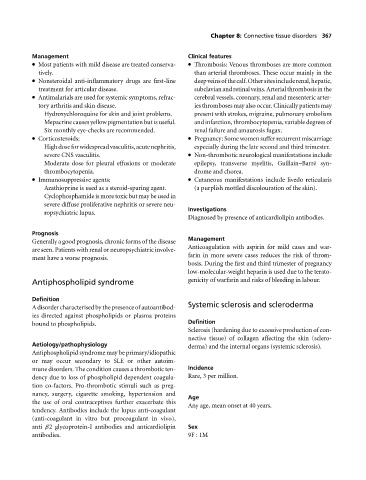Page 371 - Medicine and Surgery
P. 371
P1: KTX
BLUK007-08 BLUK007-Kendall May 12, 2005 19:48 Char Count= 0
Chapter 8: Connective tissue disorders 367
Management Clinical features
Most patients with mild disease are treated conserva- Thrombosis: Venous thromboses are more common
tively. than arterial thromboses. These occur mainly in the
Nonsteroidal anti-inflammatory drugs are first-line deepveinsofthecalf.Othersitesincluderenal,hepatic,
treatment for articular disease. subclavianandretinalveins.Arterialthrombosisinthe
Antimalarials are used for systemic symptoms, refrac- cerebral vessels, coronary, renal and mesenteric arter-
tory arthritis and skin disease. ies thromboses may also occur. Clinically patients may
Hydroxychloroquine for skin and joint problems. present with strokes, migraine, pulmonary embolism
Mepacrinecausesyellowpigmentationbutisuseful. and infarction, thrombocytopenia, variable degrees of
Sixmonthly eye-checks are recommended. renal failure and amaurosis fugax.
Corticosteroids: Pregnancy: Some women suffer recurrent miscarriage
Highdoseforwidespreadvasculitis,acutenephritis, especially during the late second and third trimester.
severe CNS vasculitis. Non-thrombotic neurological manifestations include
Moderate dose for pleural effusions or moderate epilepsy, transverse myelitis, Guillain–Barr´ e syn-
thrombocytopenia. drome and chorea.
Immunosuppressive agents: Cutaneous manifestations include livedo reticularis
Azathioprine is used as a steroid-sparing agent. (a purplish mottled discolouration of the skin).
Cyclophosphamide is more toxic but may be used in
severe diffuse proliferative nephritis or severe neu-
Investigations
ropsychiatric lupus.
Diagnosed by presence of anticardiolipin antibodies.
Prognosis
Management
Generally a good prognosis, chronic forms of the disease
Anticoagulation with aspirin for mild cases and war-
are seen. Patients with renal or neuropsychiatric involve-
farin in more severe cases reduces the risk of throm-
ment have a worse prognosis.
bosis. During the first and third trimester of pregnancy
low-molecular-weight heparin is used due to the terato-
Antiphospholipid syndrome genicity of warfarin and risks of bleeding in labour.
Definition
A disorder characterised by the presence of autoantibod- Systemic sclerosis and scleroderma
ies directed against phospholipids or plasma proteins
bound to phospholipids. Definition
Sclerosis (hardening due to excessive production of con-
nective tissue) of collagen affecting the skin (sclero-
Aetiology/pathophysiology derma) and the internal organs (systemic sclerosis).
Antiphospholipid syndrome may be primary/idiopathic
or may occur secondary to SLE or other autoim-
mune disorders. The condition causes a thrombotic ten- Incidence
dency due to loss of phospholipid dependent coagula- Rare, 3 per million.
tion co-factors. Pro-thrombotic stimuli such as preg-
nancy, surgery, cigarette smoking, hypertension and
Age
the use of oral contraceptives further exacerbate this
Anyage, mean onset at 40 years.
tendency. Antibodies include the lupus anti-coagulant
(anti-coagulant in vitro but procoagulant in vivo),
anti β2glycoprotein-I antibodies and anticardiolipin Sex
antibodies. 9F : 1M

